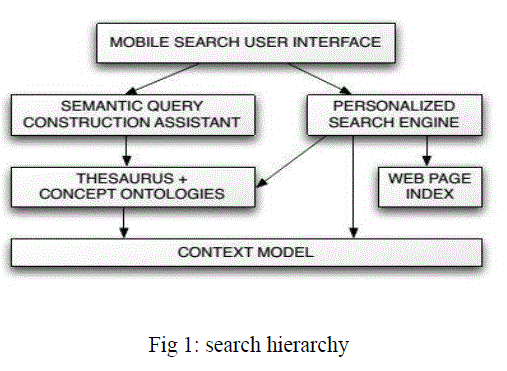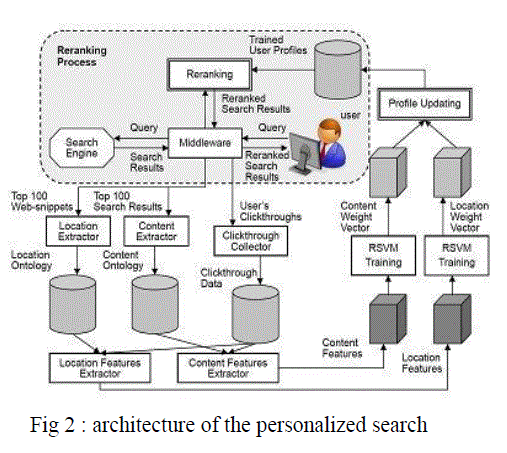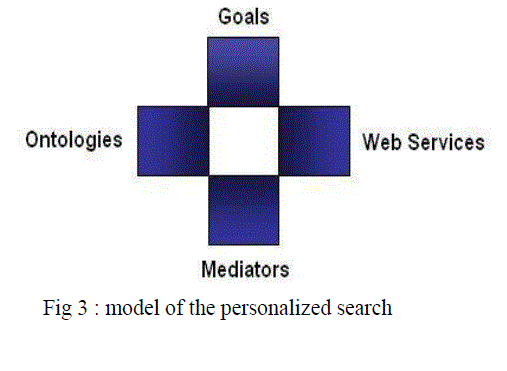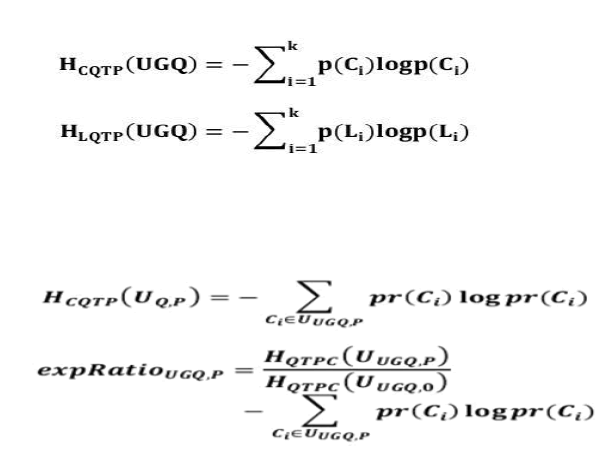ISSN ONLINE(2319-8753)PRINT(2347-6710)
ISSN ONLINE(2319-8753)PRINT(2347-6710)
M.Mahalakshmi1, R.Deepak1 and Dr.R.Nedunchelian2
|
| Related article at Pubmed, Scholar Google |
Visit for more related articles at International Journal of Innovative Research in Science, Engineering and Technology
PMSE, Personalized Mobile Search Engine has been developed to display any user desired result or reranked result in accordance with the user given query (UGQ) which includes content and the location of the user. It works efficiently with the help of ontology-based, multi user profile. User preferences are framed based on the clickthrough data, ARM ( Association rule mining ) and Joachims proposed techniques such as spying technique and novel voting method. Query processing is another important aspect which is been supervised by content ontology agent and location ontology agent, query typed (geo or non-geo) and users‟ location (using GPS) respectively. Re-ranked list is prepared after analysing the diversity-relevance entropies. Like the web search performance, enhanced PMSE also has appeasing users expectation. EPMSE is a client- server model. Client captures the user‟s query ,conveyes the needs of the server and displays the re-ranked result. Server performs the search action and prepares the desired output. EPMSE does meta search on engines such as Google, Yahoo.
Keywords |
| Ontology, Click-through data, Spying technique, ARM, Novel voting. |
INTRODUCTION |
| The small form factors of the mobile device limits the interaction between the mobile user and the search engines. In order to get a highly relevant result, user profiling is recommended. User profiling is nothing but the mobile search engines capturing the user interest to personalize. User interest personalization is based on the concept preferences [5][6][10]. Previous works are based mostly on same types, this proposed enhanced personalized search engine works on different types of concepts in different ontologies [1]. |
| In personalized mobile search engine (PMSE) that captures the users „preferences in the form of concepts by mining their click through data. Knowing the importance of the location information in mobile search, this search engine captures user‟s preferences in the form of concepts viz., content concept and location concept. Location information are supplement to the location concept. User can also submit the location by simply typing it on a particular column or GPS helps. The user preferences are organized in an ontology-based, multi facet user profile, which are used to adapt a personalized ranking function for rank adaptation of future search results. To characterize the diversity of the concepts associated with a query and their relevance‟s to the user‟s need, four entropies are introduced to balance the weights between the content and location facets[1]. |
| Re-ranking is about giving ranks to the already ranked list based on the expectations, given query.For example, top five resorts in a tourist area is listed before on a government website based on the facilities announced by the tourist department. An user needs to find a resort with some facilities such as laundary, restaurant with the medium fair. The desired output is displayed by the EPMSE client.Knowledge Discovery in Databases is the process of searching for hidden knowledge in the massive amounts of data that we are technically capable of generating and storing. Data, in its raw form, is simply a collection of elements, from which little knowledge can be gleaned. With the development of data discovery techniques the value of the data is significantly improved. |
| Search results have become increasingly complex and that trend is likely to continue. The traditional model of 10 blue links and rank checking is no longer accurate as users are receiving results that are increasingly customized to them. As results are becoming more personalized, it‟s valuable to better understand how personalized search results are being presented to users. |
RELATED WORK |
| A personalized mobile search engine, PMSE that captures the users‟ preferences in the form of concepts by mining their click through data. Due to the importance of location information in mobile search, PMSE classifies these concepts into content concepts and location concepts. In addition, users‟ locations (positioned by GPS) are used to supplement the location concepts in PMSE. The user preferences are organized in an ontology-based, multi-facet user profile, which are used to adapt a personalized ranking function for rank adaptation of future search results. To characterize the diversity of the concepts associated with a query and their relevance to the users need, four entropies are introduced to balance the weights between the content and location facets. |
| Based on the client-server model, we also present a detailed architecture and design for implementation of PMSE. In our design, the client collects and stores locally the click through data to protect privacy, whereas heavy tasks such as concept extraction, training and reranking are performed at the PMSE server. Moreover, we address the privacy issue by restricting the information in the user profile exposed to the PMSE server with two privacy parameters. We prototype PMSE on the Google Android platform. |
| Mobile based search engine the major problem is that the interaction between mobile users and search results are managed by small numeral of factors in the mobile phones.In order to manage these problem collect user query and their relevant result to satisfy the user profile according to the interest. To perform this by observing the different types of concepts in the personalized mobile search engine (PMSE), it captures the user preferences concepts by mining click through data. In Personalized mobile search engine (PMSE) preferences of each user are ordered in ontology based model and each user profiles are ranked with the use of multi-facet for future search results. The search result can be classified into location and content based concepts based on their importance information. Improve the PMSE result by investigate methods to develop normal query travel patterns from the location and click through data to further enhance the personalization effectiveness of PMSE. By introducing an association rule mining algorithm collect the different travel patterns byoriginal search engine result in each and every query of user from the original personal mobile search engine profile. Association rule learning is used for finding the interesting query travel pattern results from each user query in PMSE search engine. From this query related patterns of the user to identify strong rules discovered in databases using different measures of interestingness. They introduced association rules for discovering regularities between normal patterns and query related patterns in the personalized mobile search engine result. |
 |
| Search engine plays a major important way to search the applicable information from the Web. Though, the investigate results acquire may not forever be cooperative to the user, as investigate engine fail to be familiar with the user purpose behind the query. Because the exacting word might denote numerous things in different contexts and the predictable background can be strong-minded by the user unaccompanied.For picture, particular a investigate keyword “apple”, a consumer might be penetrating intended for fruit apple or for apple computer. Characteristic search engines provide alike set of consequences without bearing in mind of who submit the query. Consequently, the obligation arises to have personalized web search organizations which give yield suitable to the user as extremely ranked pages. |
CLICK THROUGH PROCESS |
| To manipulate this type of issues personalized user profile based system are proposed in previous work personalized Web searches have been developed. In personalized search (PS) how to adeptly attain user‟ information requirement is a key difficulty. Therefore it is tremendous to achieve user‟s need simply from the user given query or keywords. In web search system the main difficulty isthat doesn‟t imagine concerning the difference surrounded by personality user needs.To overcome this difficult by integrating information the meta-search engine in mobile surroundings. Meta search engine with personalized helps individuals search problem to find the important information according to user's interest. |
| None of the previous work support the result based on concept and location based results. It either considering the location or concepts in single manner not produces both results simultaneously by observe the requirements of dissimilar type of users, there personalized mobile search engine (PMSE) which represent disparate type of concepts in disparate ontology‟s. it categorize the user information into both content and location based concept from user given query with personal search engine result .It adopts the meta search engine approach which relies on marketable search engines such as Google, Yahoo to achieve a actual search. The client is responsible for receiving the user‟s requests, conveyance the needs to the PMSE server, display the return consequences. Lastly collecting their click throughs in organizes to obtain their personal preferences.The PMSE server is responsible for performing the task to the main search engine and as well as rank the results according the different user and their similar query based results in the server side and return result to the client side in PMSE. To distinguish the diversity of the concepts associated with a query and their relevancies‟ to the user‟s preferences, dissimilar entropy measures are introduce to equilibrium the weights among the content and location concepts. Personalized mobile search engine (PMSE) which makes the use of completed information presented. |
 |
| PMSE finding the content and location based concepts for user profiling; it utilize similarly the content and location preference to personalize search consequences for a user. PMSE accept the server-client model in which consumer query are promote to a PMSE server for dealing out the training and reranking quickly with RSVM. PMSE clients working with Android platform and the PMSE server on a PC to confirm the results. Experiential result demonstrates that our design conserve expertly key user needs.Association Rule Mining (ARM) query travel pattern to explore for go target that is user concept consequences ,practical data mining and association rules method to investigate the association among travelers‟ profile and their transactions in the data .After this examine the identify majority important pattern to investigate the outcome and can amplify opportunity for the competitive operations of tourism firm to respond the travelers‟ demand effectively. |
LOCATION ONTOLOGY |
| Extract location concepts are different from with the purpose of extracting content concepts with similar query travel patterns results from ARM. The predetermined location ontology with QTP is used to associate region information with the explore results. The entire part of the keywords and key-phrases from the Query patterns documents (QPD) returned for query (UGQ) are extracted with exact matches of the results in location concept. |
 |
CONTENT ONTOLOGY |
| Content ontology method extracts all the keywords or terms and phrases from the web snippets and search engine results by user given query (UGQ). Here the most repeated UGQ based query patterns are analyzed after that it calculate the confidence value for moat time occurrence of the USQ in top documents measure the amount of a particular keyword/phrase Ci with value to UGQ where ( ) is the snippet frequency related to concepts Ci and n is the number of web-snippets from UGQ and | Ci | is the numeral of conditions in the keyword/phrase Ci ( ) is the snippet frequency containing the most related information. |
DIVERSITY AND CONCEPT ENTROPY |
| Measuring the diversity between the location and content ontology based results with similar in search engine .here the PMSE consist of a content feature and a location feature it select the consequences based on the entropy can be designate the uncertainty associated among the information comfortable of the investigate results from the user‟s point of Query Travel Patterns(QTP). Two entropies calculate content entropy H (CUGQ) and location entropy H (LUGQ) to calculate the uncertainty associated with the content and location information in the search engine result of each user preferences |
 |
SIMULATION & RESULTS |
| Our experiments showed significant improvement over methods that do not consider implicit feedback. The gains are particularly dramatic for the top K=1 result in the final ranking, with precision improvements as high as 31%, and the gains are substantial for all values of K. Our experiments showed that implicit user feedback can further improve web search performance, when incorporated directly with popular content- and link-based features. |
CONCLUSION |
| In a personalized web search systems are based click through data to determine users‟ preferences. Joachims proposed to mine document preferences from click through data. Proposed to combine a spying technique together with a novel voting procedure to determine user preferences. In introduced an effective approach to predict users‟ conceptual preferences from click through data for personalized query suggestions. Search queries can be classified as content (i.e.,non-geo) or location (i.e., geo) queries. Examples of location queries are “hongkong hotels”, “museums in london” and “virginia historical sites”. In, Gan, et. al., developed a classifier to classify geo and non-geo queries. It was found that a significant number of queries were location queries focusing on location information. In order to handle the queries that focus on location information, a number of location-based search systems designed for location queries have been proposed. |
References |
|